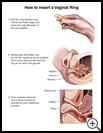
Vaginal Contraceptive Ring: Teen Version
________________________________________________________________________
KEY POINTS
- The vaginal contraceptive ring is a soft ring you put into the vagina to prevent pregnancy. The ring contains man-made forms of the female hormones estrogen and progesterone. They are the same hormones used in birth control pills.
- Make sure you know how and when to change the ring. Ask your healthcare provider what you should do if the ring accidentally comes out.
- Ask your healthcare provider or pharmacist what side effects the medicine may cause and what you should do if you have side effects.
________________________________________________________________________
What is the vaginal contraceptive ring used for?
The vaginal contraceptive ring is used to keep you from getting pregnant. It's a soft ring you put into the vagina. The ring has the same medicine as birth control pills. The vaginal ring is one of the most reliable forms of birth control.
The ring must be prescribed by your healthcare provider.
How does the vaginal ring work?
The vaginal ring contains medicine that is similar to a woman’s natural hormones. Normally, the hormones control the release of an egg from an ovary each month. Using a vaginal ring changes the hormone levels and keeps the ovaries from releasing an egg. If the ovaries don’t release an egg, you cannot get pregnant. The hormones also cause a thickening of the mucus on the cervix and change the lining of the uterus. These changes also help prevent pregnancy.
The ring contains man-made forms of the female hormones estrogen and progesterone. They are the same hormones used in birth control pills. The ring releases hormones into the body.
When you use the vaginal ring, your periods are regular and usually lighter. Menstrual cramps may not be as painful. The symptoms of premenstrual syndrome (PMS) may not be as bothersome.
What else do I need to know about this medicine?
- Follow the directions that come with your medicine, including information about food or alcohol. Make sure you know how and when to change the ring. Ask your healthcare provider what you should do if the ring accidentally comes out.
- Use a backup method of birth control, such as condoms and spermicide, until you have been using the ring for 7 days.
- The vaginal ring does not keep you from getting AIDS or other sexually transmitted diseases. Latex or polyurethane condoms are the only method of birth control that can protect against the HIV virus and AIDS.
- Many medicines have side effects. A side effect is a symptom or problem that is caused by the medicine. Ask your healthcare provider or pharmacist what side effects the medicine may cause and what you should do if you have side effects.
- Smoking while you are using this medicine increases the risk of serious side effects. Talk to your healthcare provider about ways to quit smoking.
- Keep a list of your medicines with you. List all of the prescription medicines, nonprescription medicines, supplements, natural remedies, and vitamins that you take. Tell all healthcare providers who treat you about all of the products you are taking.
- Try to get all of your prescriptions filled at the same place. Your pharmacist can help make sure that all of your medicines are safe to take together.
If you have any questions, ask your healthcare provider or pharmacist for more information. Be sure to keep all appointments for provider visits or tests.
Last modified: 2016-02-23
Last reviewed: 2016-02-10

